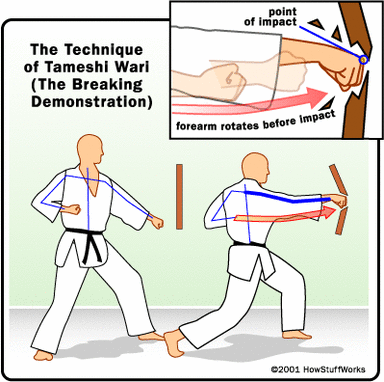When the ancient martial arts masters were developing their sophisticated fighting techniques, they experimented with fundamental principles of physics. In any fight between two people, both fighters bring a certain amount of energy to the situation. The total amount of potential energy depends on the fighters’ size, muscle strength and physical health. The object of karate is to use your body to channel this energy.
Generally, a stronger, larger person can exert more energy than a weaker, smaller person. But this doesn’t necessarily determine the victor. There are all sorts of ways that energy can be expressed. Depending on the particular way you exert energy, you can vary the intensity and direction of the force you produce.

At its most basic, karate is a system for varying the forces of a fight to your ownadvantage. There are several ways to do this.
First of all, you concentrate all of your strength into a relatively small area. If you open your hands wide and shove somebody, the force of your attack spreads out across your palm and fingers. This dissipates the force of your attack over a fairly wide area; your opponent feels a relatively blunt force. But if you hold all of your fingers tightly together and hit the person with only the side of your hand, or with only your fingertips, that same amount of force is applied to a much smaller area. In that area, the impact is much more intense. If you try this on yourself (gently, please), you can appreciate the difference. The concentrated attack is a lot more painful.
In karate, there are a number of punching and kicking stances, but most of them rely on this same basic idea. The point of impact is reduced to some small, usually bony area of your hand or foot, and the force of your attack is focused on this point. Karatekas strengthen their hands and feet so they can throw these punches and kicks without seriously hurting themselves. It is crucial to practice excellent technique; if a karateka continually punches incorrectly, he or she may eventually develop severe arthritis.
Karatekas maximize the force of the impact by putting their whole body into the punch or kick. If you watch karatekas fight, you’ll see that they often pivot their torso and shift their weight from one leg to the other when they throw a punch. In this way, the energy of their moving body goes into each hit along with the energy of the arm muscles. Karatekas also practice hitting with great speed, as this increases the force of each blow.

One of the most important elements in karate is following through on punches and kicks. When you hit something, say a piece of board, your natural instinct is to slow down your swing just before impact; you hesitate because you don’t want to hurt your hand. Karatekas deprogram this hesitation instinct; they visualize pushing their fist to some point past their target (the other side of the board, for example). To maximize the force of each movement, it’s essential that the karateka follows through. Before each attack, karatekas take a deep breath. As they release the punch or kick, they let this breath out. This helps them focus on each movement.
